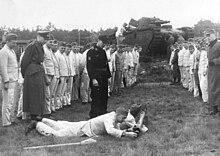Grosstraktor
- View a machine-translated version of the Russian article.
- Machine translation, like DeepL or Google Translate, is a useful starting point for translations, but translators must revise errors as necessary and confirm that the translation is accurate, rather than simply copy-pasting machine-translated text into the English Wikipedia.
- Consider adding a topic to this template: there are already 1,235 articles in the main category, and specifying
|topic=will aid in categorization. - Do not translate text that appears unreliable or low-quality. If possible, verify the text with references provided in the foreign-language article.
- You must provide copyright attribution in the edit summary accompanying your translation by providing an interlanguage link to the source of your translation. A model attribution edit summary is
Content in this edit is translated from the existing Russian Wikipedia article at [[:ru:Grosstraktor]]; see its history for attribution. - You may also add the template
{{Translated|ru|Grosstraktor}}to the talk page. - For more guidance, see Wikipedia:Translation.
maximum: 44 km/h (27 mph) (Krupp)
sustained: 25 km/h (16 mph)
Grosstraktor (German: "large tractor") was the codename given to six prototype medium tanks built (two each) by Rheinmetall-Borsig, Krupp, and Daimler-Benz, for the Weimar Republic, in violation of the Treaty of Versailles. Constructed in secret, they were tested by Reichswehr units at the Kama tank school in the Soviet Union. They were used for training and retired as monuments after the Nazi party came to power.[1]
Development history

After the first World War, Germany realized the value of tanks in warfare. In 1925, plans to design tanks for the Reichswehr were secretly initiated. The Grosstraktor was the first of the tank designs for the Reichswehr.
The Grosstraktor began life when design specifications for a tank known as the "Armeewagen 20" were created in 1926. It was to be a 15 tonne tank armed with a 7.5 cm gun in a fully rotating turret and having a length of 6 meters and a width of 2.4 meters. Contracts to design and build two chassis in soft steel were given to Daimler-Benz, Krupp, and Rheinmetall in March 1927. Krupp designed a turret for their own vehicle, while Rheinmetall designed a turret for both their own and Daimler-Benz's tanks.[2]
Construction of the six Grosstraktor was started at a Rheinmetall shop in Unterlüß in August 1928, and was completed by the end of June 1929. They were then shipped to a secret testing ground near Kazan, Russia for trials, arriving in July 1929. There, Mk 6/380/160 track links replaced the originals. [2]
References
- ^ Peter Chamberlin and Hillary Doyle, Encyclopedia of German Tanks of World War Two, 1978, 1999, p. 147
- ^ a b Jentz (1997), p. 4-2.
Bibliography
- Jentz, Thomas L. (1997). Panzer Tracts No. 4 Panzerkampfwagen IV. Darlington, Maryland: Darlington Productions Inc. ISBN 0-96487-934-4.
External links
- http://www.achtungpanzer.com/leichte-traktor-grosstraktor-i-ii-iii-neubaufahrzeug-pzkpfw-v-vi.htm Archived 2016-07-16 at the Wayback Machine
- v
- t
- e
- AH-IV
- Carden Loyd
- L3/33
- L3/35
- R-1
- T-27
- T-32 (Š-I-D)
- Tančík vz. 33
- TKS
- Type 92
- Type 94
- Type 97 Te-Ke
- 7TP
- 38M Toldi I
- Char D1
- Disston Tractor Tank
- Fiat 3000
- H35
- L-60
- Light tanks Mk I–V
- Light Tank Mk VI
- Light Tank Mk VII
- LT vz. 34
- LT vz. 35
- LT vz. 38
- M1 combat car
- M2 Light Tank
- Panzer I
- Panzer II
- R35
- T-18
- T-26
- T-37
- T-38
- Type 95 Ha-Go
- Vickers 6-Ton
- Vickers-Carden-Loyd light amphibious tank
- Vickers T-15
- FCM 36
- Hotchkiss H35
- Matilda I
- T-26
experimentals
- 10TP
- FCM F1
- Grosstraktor
- Kolohousenka
- Landsverk L-120
- Leichttraktor
- Medium Mark III
- Medium Mark D
- Medium Tank A7
- Morris-Martel
- Neubaufahrzeug
- PZInż 130
- Škoda MU-4
- SMK
- Straussler V-4
- Stridsvagn m/31
- ST vz. 39
- T1 Light Tank
- T2 Medium
- T7 Combat Car
- T-19
- T-42
- T-100
- Type 87 Chi-I
- Type 91 heavy
- Type 95 heavy
- Type 97 Chi-Ni
- Type 98 Chi-Ho
- Verdeja
- Vickers A1E1 Independent
 Interwar period tanks
Interwar period tanks List of interwar armoured fighting vehicles
List of interwar armoured fighting vehicles
Background: History of the tank, Tank classification, interwar period














